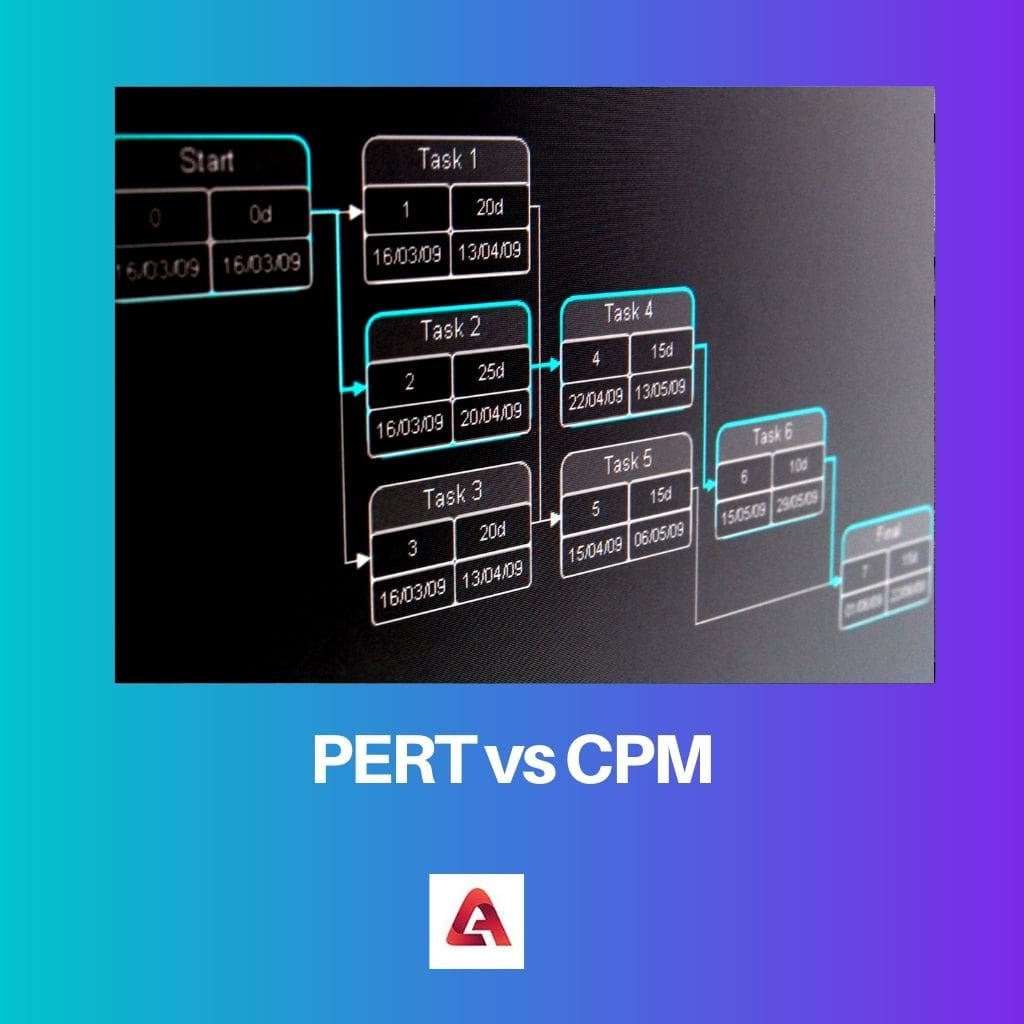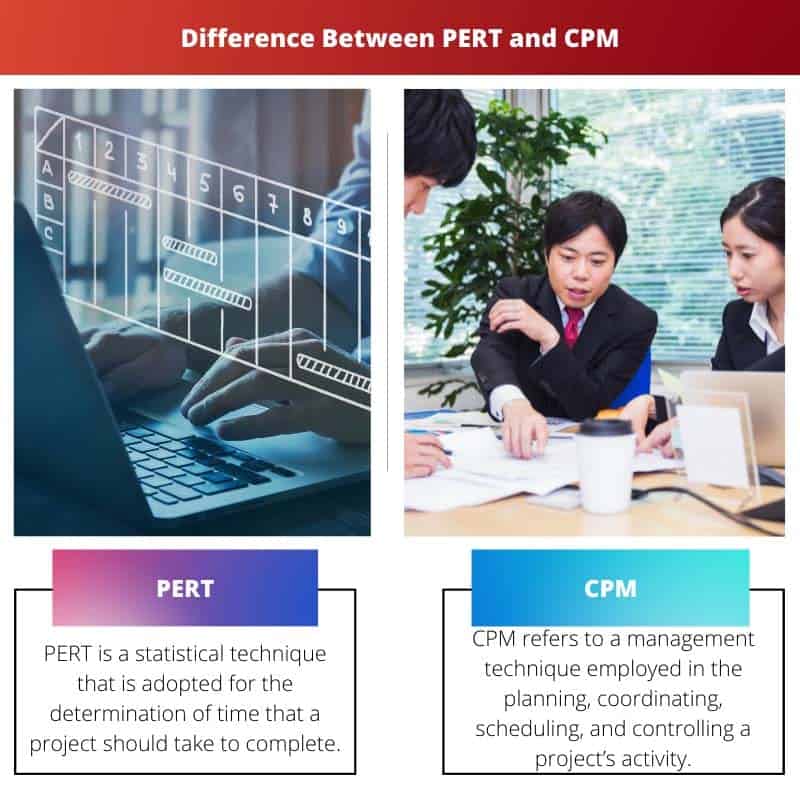PERT (Program Evaluation and Review Technique) is a probabilistic method in project management that utilizes three time estimates to calculate the expected duration of activities and overall project completion time, considering uncertainties. Conversely, CPM (Critical Path Method) is deterministic, focusing on identifying the critical path – the longest sequence of dependent activities – to ascertain the minimum time needed for project completion, making it ideal for projects with well-defined tasks and clear dependencies.
Key Takeaways
- PERT (Program Evaluation and Review Technique) is a project management tool emphasizing time and uncertainty, while CPM (Critical Path Method) focuses on task duration and precedence relationships.
- PERT uses probabilistic time estimates to analyze and control project schedules, while CPM relies on deterministic time estimates for the same purpose.
- PERT is more suitable for complex, uncertain projects with high interdependency, while CPM is better for well-defined projects with clear task sequences.
PERT vs CPM
PERT is an acronym that stands for project management and review technique, and it is a statistical tool that’s used to judge the timeframe in which a project can be completed. CPM means critical path method and it’s a technique used during the planning of a project to manage cost and time.

In PERT, the prime focus is to plan and manage time, whereas in CPM, the prime focus is to control cost and time.
Comparison Table
| Feature | PERT | CPM |
|---|---|---|
| Focus | Time Management: Estimating and minimizing project duration. | Time-Cost Trade-off: Balancing project duration with cost. |
| Model type | Probabilistic: Uses three time estimates for each activity (optimistic, most likely, pessimistic) to account for uncertainty. | Deterministic: Uses a single, fixed time estimate for each activity, assuming certainty. |
| Time estimates | Three estimates: Optimistic (to), Most Likely ™, Pessimistic (tp) | One estimate |
| Suitable for projects | Uncertain, research and development projects, novel undertakings. | Well-defined, routine projects with predictable activities. |
| Network diagram elements | Represents events (milestones) connected by activities. | Represents activities connected by arrows. |
| Critical path identification | Considers statistical variations in activity times to identify the most likely critical path. | Identifies the single longest path through the network as the critical path. |
| Resource allocation | Less emphasis on resource allocation. | Can be used to identify resource constraints and optimize resource allocation. |
| Cost management | Limited focus on cost aspects. | Can be used to analyze cost-time trade-offs and schedule activities based on cost constraints. |
| Software support | Widely supported by project management software. | Widely supported by project management software. |
What is PERT?
PERT, which stands for Program Evaluation and Review Technique, is a project management tool primarily used to schedule, organize, and coordinate tasks within a project. Developed in the late 1950s by the U.S. Navy, PERT was originally designed to manage the Polaris submarine missile program. Today, it is widely employed in various industries, including construction, engineering, software development, and research projects.
Methodology and Principles
- Three Time Estimates: PERT utilizes three time estimates for each task:
- Optimistic Time (O): The minimum time required to complete an activity under ideal conditions.
- Most Likely Time (M): The best estimate of the time needed to complete an activity based on realistic conditions.
- Pessimistic Time (P): The maximum time required to complete an activity under adverse conditions.
- Expected Time Calculation: PERT combines these three estimates to calculate the expected time (TE) for each task using the formula: TE=(O+4M+P)/6
- Critical Path Analysis: PERT determines the critical path, which is the longest sequence of dependent activities that determine the overall duration of the project. Activities on the critical path have zero slack or float time, meaning any delay in these tasks will directly impact the project’s completion time.
- Probability Distributions: Unlike the deterministic approach of the Critical Path Method (CPM), PERT incorporates probability distributions to account for uncertainty in task durations. This allows project managers to assess the probability of meeting specific project deadlines and to make informed decisions regarding resource allocation and scheduling.
Advantages of PERT
- Risk Management: PERT helps in identifying and managing project risks by providing a probabilistic view of project timelines, enabling project managers to allocate resources more effectively and plan for contingencies.
- Flexibility: PERT accommodates uncertainties and variations in task durations, making it suitable for projects with complex and non-linear workflows where estimates may be difficult to determine with certainty.
- Visualization: PERT diagrams provide a visual representation of project tasks and their interdependencies, facilitating communication among project stakeholders and fostering better understanding of project timelines and resource requirements.
- Performance Monitoring: By comparing actual progress against estimated timelines, PERT enables project managers to monitor project performance and take corrective actions as needed to ensure project success.

What is CPM?
The Critical Path Method (CPM) is a project management technique used to determine the longest sequence of dependent activities, known as the critical path, and to ascertain the minimum time required to complete a project. Developed in the late 1950s by Morgan R. Walker of DuPont and James E. Kelley Jr. of Remington Rand, CPM has become one of the most widely used methods for scheduling and managing projects across various industries.
Methodology and Principles
- Activity Identification: CPM begins with identifying all the activities required to complete a project, along with their dependencies and durations. Activities are represented as nodes, and dependencies between them are represented as directed edges in a network diagram.
- Activity Sequencing: Once activities are identified, they are sequenced based on their dependencies to create a network diagram, also known as a precedence diagram or network model. This diagram illustrates the logical relationships between activities and forms the basis for further analysis.
- Critical Path Determination: The critical path is the longest sequence of dependent activities that determine the overall duration of the project. It represents the shortest time in which the project can be completed without any delay. Activities on the critical path have zero slack or float time, meaning any delay in these tasks will directly impact the project’s completion time.
- Forward and Backward Pass: CPM uses forward and backward pass techniques to calculate the earliest start and finish times, as well as the latest start and finish times, for each activity in the network diagram. This information helps identify the critical path and determine the total project duration.
Advantages of CPM
- Efficient Resource Allocation: By identifying the critical path and non-critical activities, CPM enables project managers to allocate resources more efficiently, focusing on tasks that directly impact project completion.
- Schedule Optimization: CPM provides a clear understanding of task dependencies and their impact on project timelines, allowing project managers to optimize the project schedule by adjusting activity durations or resource allocations as needed.
- Risk Management: While CPM is deterministic and does not explicitly account for uncertainty in task durations, it allows project managers to identify potential delays and bottlenecks in advance, enabling proactive risk management and mitigation strategies.
- Performance Monitoring: CPM provides a baseline schedule against which actual progress can be compared, allowing project managers to monitor project performance and take corrective actions as needed to ensure project success.

Main Differences Between PERT and CPM
- Approach:
- PERT (Program Evaluation and Review Technique) is probabilistic, incorporating three time estimates (optimistic, most likely, pessimistic) and probability distributions to account for uncertainty in task durations.
- CPM (Critical Path Method) is deterministic, focusing on identifying the critical path – the longest sequence of dependent activities – to determine the minimum time needed for project completion based on fixed task durations.
- Time Estimation:
- PERT uses three time estimates (optimistic, most likely, pessimistic) for each activity and calculates the expected time considering uncertainties using a weighted average formula.
- CPM relies on single-point estimates for activity durations, assuming fixed durations for each task without considering uncertainties.
- Critical Path Analysis:
- PERT emphasizes the overall project timeline and identifies tasks with high variability, but does not explicitly focus on critical path analysis.
- CPM identifies the critical path, which is crucial for timely project completion, and emphasizes tasks directly impacting project duration, facilitating efficient resource allocation and schedule optimization.
- Flexibility:
- PERT is more suitable for projects with uncertain or variable task durations, providing flexibility in handling complex and non-linear workflows.
- CPM is ideal for projects with well-defined tasks and clear dependencies, offering a straightforward approach for scheduling and managing projects with fixed durations.


This article provides a comprehensive overview of PERT and CPM, offering valuable insights into their respective functionalities.
The detailed comparison between PERT and CPM is enlightening. It’s helpful to understand the strengths and weaknesses of each method.
Indeed, having a clear understanding of the differences between PERT and CPM can assist project managers in making informed decisions about project planning and scheduling.
The contrast between PERT and CPM is elucidated with precision, shedding light on their unique characteristics and areas of relevance.
Absolutely, the detailed comparison equips project managers with the knowledge necessary to make informed decisions in project planning and execution.
This article succeeds in demystifying the nuances of PERT and CPM, enabling readers to grasp the fundamental distinctions between the two methods.
While PERT and CPM have distinct applications, project managers should also consider newer methodologies that address the evolving needs of project management.
Agreed, the dynamic nature of projects today demands innovative approaches that can adapt to changing conditions and requirements.
The comparison table effectively encapsulates the key disparities between PERT and CPM, enabling a clear understanding of their divergent applications.
Absolutely, the concise presentation of differences facilitates a nuanced comprehension of the two methodologies.
The comparison table serves as a valuable reference for project managers seeking to navigate the complexities of project scheduling and management.
Great analysis of PERT and CPM, very informative and well-explained.
I completely agree, the article is thorough and clear in its explanations. A valuable resource for project managers.
The historical context of PERT’s development provides valuable insights into the origins and evolution of project management methodologies.
Indeed, understanding the historical underpinnings of PERT enhances our appreciation of its role in shaping modern project management practices.
While PERT and CPM certainly have their merits, they may not always be suitable for every project. Flexibility and adaptability are important in project management.
Absolutely, project managers need to consider the unique characteristics of each project and choose the most appropriate approach.
That’s a valid point, Jim. Some projects may require a combination of methods to effectively manage time, cost, and uncertainty.
The in-depth explanation of PERT’s key features and concepts is truly beneficial for project practitioners seeking to enhance their knowledge.
The detailed breakdown of PERT’s components facilitates a deeper comprehension of its application in project management.
Absolutely, understanding the fundamental principles of PERT can empower project managers to make more informed decisions in complex project environments.